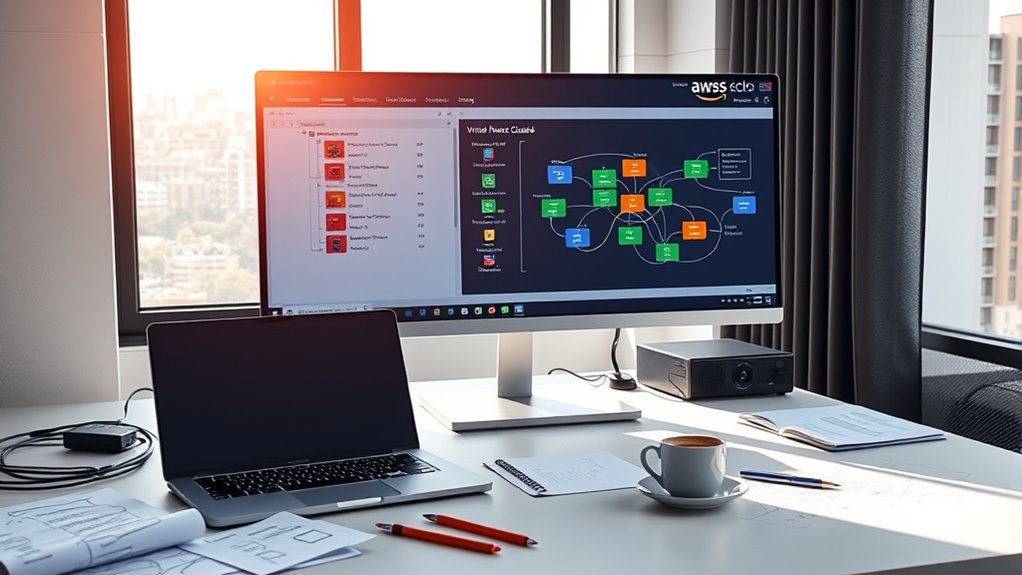To set up a Virtual Private Cloud (VPC) in AWS, start by creating the VPC and configuring your subnets, ensuring you define public and private subnets as needed. Then, set up Internet and NAT Gateways for secure internet access. Manage route tables to direct traffic effectively, and implement security measures like Security Groups and Network ACLs. Finally, launch EC2 instances while considering best practices for performance and security. There's much more to learn about optimizing your VPC setup.
Understanding the Purpose of a VPC
A Virtual Private Cloud (VPC) is fundamentally your own isolated network within the vast AWS cloud ecosystem, offering you the ability to securely place and manage resources. One of the key VPC benefits is resource isolation, ensuring that your resources remain separate from those of other AWS users, enhancing your security posture. Through network segmentation, you can create multiple subnets within the VPC, allowing for organized and secure resource management. Additionally, VPCs support hybrid cloud configurations, seamlessly integrating your on-premises infrastructure with cloud resources. This flexibility empowers you to customize your network layout, control traffic, and scale resources dynamically, all while maintaining compliance and robust monitoring capabilities. Your freedom in managing resources is greatly amplified within a VPC, as subnets facilitate traffic control within different parts of the cloud environment.
Configuring Your VPC Subnets
When configuring your VPC subnets, it is crucial to understand the role they play in managing your AWS resources effectively. Subnets help you define your network architecture, ensuring ideal placement and security of resources. Here are three key considerations:
Understanding VPC subnets is essential for effective AWS resource management and securing your network architecture.
- Subnet Types: Determine whether you'll use public, private, VPN-only, or isolated subnets based on your application needs. Additionally, consider using AWS abstractions to simplify the networking complexities involved in managing subnets.
- Subnet Security: Implement Network ACLs and security groups to control traffic flow and enhance security across your subnets.
- Subnet Routing: Associate each subnet with a route table to manage outbound traffic effectively, allowing you to route data to internet gateways or NAT gateways as necessary.
Setting Up Internet and NAT Gateways
To establish connectivity between your VPC and the internet, you'll need to configure Internet Gateways and NAT Gateways effectively. This process involves setting up your IGW to manage inbound and outbound traffic, while ensuring your NAT Gateway allows private subnet resources to access the internet securely. Additionally, implementing redundancy strategies for your gateways will enhance the reliability of your network architecture. The Internet Gateway's role is crucial for enabling internet access for resources within your VPC.
Internet Gateway Configuration
Setting up an Internet Gateway is essential for enabling your AWS VPC to communicate with the Internet. This logical connection allows your resources to access the web and receive external traffic. Follow these steps to guarantee a smooth configuration:
- Create the Internet Gateway via the AWS VPC console, providing a name.
- Attach the Internet Gateway to your VPC to enable internet access.
- Configure your route table, adding a route with the destination CIDR of 0.0.0.0/0.
For peak performance, adhere to Internet Gateway Best Practices, including regular traffic monitoring and implementing Security Group Integration. These practices will help you maintain control over incoming and outgoing traffic, enhancing your VPC's security and efficiency.
NAT Gateway Setup
NAT Gateways play an essential role in enabling instances within private subnets to access the Internet while maintaining security by preventing unsolicited inbound connections. To set up a NAT Gateway, follow these steps:
| Step | Description |
|---|---|
| 1. Subnet Selection | Choose a public subnet for NAT Gateway deployment. |
| 2. Create Gateway | Specify a name, select the subnet, and allocate an Elastic IP. |
| 3. Route Table Update | Modify the private subnet's route table to direct Internet-bound traffic through the NAT Gateway. |
Keep in mind that NAT Gateway pricing includes charges by the minute and data transfer, which can add up. Consider NAT Gateway alternatives if cost is a concern, particularly for lower bandwidth requirements. Additionally, NAT Gateway enables secure outbound internet access for software updates and web services.
Gateway Redundancy Strategies
While designing a resilient architecture in AWS, implementing effective gateway redundancy strategies is crucial for maintaining uninterrupted internet access and secure communication within your Virtual Private Cloud (VPC). You should focus on the following strategies:
- Utilize multiple Availability Zones: Distribute your NAT and Internet Gateways across different zones to enhance availability and minimize downtime due to gateway failover. This approach aligns with the need for high availability in your network setup.
- Configure route tables and routing protocols: Verify your routing tables are set to direct traffic efficiently, leveraging dynamic routing protocols like BGP for adaptability.
- Incorporate redundant VPNs: Establish multiple VPN connections for secure, reliable communication between your on-premises and cloud resources.
Managing Route Tables and Routing
In managing route tables, you'll need to understand the basics, including how default routes are configured and how to handle IPv6 routes. Each route table plays a critical role in directing traffic within your VPC and to external resources. By effectively setting up these routes, you can optimize network performance and guarantee proper communication across your architecture. Additionally, ensuring high availability of your route tables is essential to prevent network interruptions due to misconfigurations.
Route Table Basics
Understanding route tables is essential for effective traffic management within a Virtual Private Cloud (VPC) in AWS, as they direct network traffic based on defined rules. These tables play a significant role in route table management, enabling you to establish custom route configurations for your subnets. Here are three key aspects to take into account:
- Main and Custom Route Tables: Use custom route tables for specific traffic needs, while the main table serves as a default. Additionally, it's important to note that a managed AWS resource like the Internet Gateway is necessary for internet access in conjunction with your route tables.
- Route Table Association: Each subnet must be associated with a route table; otherwise, it defaults to the main.
- Traffic Control: Routes specify destinations and targets, ensuring precise traffic flow within your VPC.
Default Route Configuration
Effective management of route tables is key to configuring default routes in your AWS Virtual Private Cloud (VPC). Each subnet can only associate with one route table, prioritizing the most specific route for traffic. Default routes are set for local IPv4 routing by default, while propagated routes from connections like Site-to-Site VPNs automatically update the route table.
| Route Type | Limitations | Notes |
|---|---|---|
| Non-Propagated | Up to 50 | Can be increased |
| Propagated | Up to 100 | Automatically updates |
| Default Routes | N/A | Established by default |
IPv6 Route Management
While managing IPv6 route tables in your AWS Virtual Private Cloud (VPC), it is important to recognize how they dictate the flow of traffic between subnets and the internet. Effective route table management is vital for seamless communication and internet access. Here are key considerations:
- Egress-Only Gateways: Use these for private subnets to allow outbound IPv6 traffic while blocking incoming traffic.
- VPC Peering: Verify both VPCs are configured for IPv6 to facilitate communication; update route tables accordingly.
- Security Group Configurations: Modify security groups to accommodate IPv6 routing rules, guaranteeing proper traffic flow. Additionally, remember that subnetting is simplified with a fixed-length scheme of 64 bits for the network prefix and 64 bits for the interface identifier.
With careful subnet planning and route management, you can achieve efficient and secure IPv6 routing within your VPC.
Implementing Security Measures for Your VPC
Security measures are essential for safeguarding your Virtual Private Cloud (VPC) in AWS. Implementing effective security group configurations and network ACL strategies is important. Here's a structured approach:
| Security Component | Purpose | Best Practice |
|---|---|---|
| Security Groups | Control instance-level traffic | Use granular rules for tighter security |
| Network ACLs | Manage subnet-level traffic | Explicitly deny all but necessary traffic |
| IAM Policies | Control access to VPC resources | Apply least privilege principle |
| VPC Flow Logs | Monitor IP traffic | Regularly review for anomalies |
| AWS Network Firewall | Filter inbound/outbound traffic | Implement for enhanced monitoring |
Regular security reviews and updates are essential to maintain compliance and address potential vulnerabilities, ensuring your VPC remains secure. Additionally, implementing NACLs for VPC-level traffic control helps to further enhance the security posture of your network infrastructure.
Launching EC2 Instances and Additional Resources
Launching EC2 instances within your AWS Virtual Private Cloud (VPC) is a crucial step in deploying applications and services. You'll want to take into account the following:
- EC2 Instance Types: Choose the right instance type based on your performance needs.
- Elastic IPs: Assign static IP addresses to your instances to maintain consistent networking.
- Security Groups: Configure security groups to manage access control effectively.
Additionally, for enhanced network security, implement NACL management to control traffic flow. By carefully selecting your instance types and configuring Elastic IPs and security groups, you'll optimize both performance and security in your VPC. It's also important to consider the selection of an appropriate model for your VPC configuration to ensure suitable network and Internet connectivity. Remember to monitor resource usage to adjust as needed for your evolving application requirements.
Frequently Asked Questions
Can I Connect My VPC to Another VPC?
Imagine two islands, each bustling with activity, yearning to share resources. You can indeed connect your VPC to another VPC using various VPC connectivity options like peering connections or transit gateways. Just remember to contemplate VPC security considerations, ensuring your IP ranges don't overlap and configuring route tables properly. This way, both VPCs can communicate seamlessly while maintaining a secure environment, allowing you the freedom to manage your cloud resources effectively.
How Do I Delete a VPC?
To delete a VPC, you'll need to guarantee a proper VPC cleanup first. Terminate all EC2 instances and delete associated resources like load balancers and NAT gateways. Access the AWS Management Console, select your VPC, and from the "Actions" menu, choose "Delete VPC." Confirm your choices, entering "delete" when prompted. Remember, VPC deletion is irreversible, so double-check all dependencies before proceeding to avoid unintended disruptions.
What Is VPC Peering?
Imagine the freedom of seamless communication between your resources, unbound by the public internet. VPC peering offers you numerous benefits, like enhanced security and reliable bandwidth, allowing private IP traffic between VPCs. However, it has limitations, such as the need for non-overlapping CIDR blocks and route table updates. By understanding VPC peering, you can harness its power to create a more interconnected and secure cloud environment, ensuring your architecture remains scalable and efficient.
How Many VPCS Can I Create per Account?
You can create up to five VPCs per Region by default, which is subject to VPC limits. If you need more, you can request a limit increase for resource management. Keep in mind that these limits apply individually to each Region, so plan accordingly. Additionally, increasing your VPC limits may also affect other resources, such as Internet Gateways, so consider overall architecture when scaling your VPCs.
Can I Change My Vpc's CIDR Block?
Oh, the freedom of changing your VPC CIDR block! Unfortunately, you can't change the primary CIDR block once it's set. It's like getting stuck with a tattoo you regret. However, you can add secondary CIDR blocks, giving you some flexibility. Just remember, if you want to remove a secondary block, all associated subnets have to go first. So, think carefully before you act—freedom comes with its own rules!



